Saturday – Home – Al, our builder, is putting a new roof on the chicken run. The tarpaulin was damaged by storms and the run is now a quagmire. He is putting up a sloping roof of clear corrugated plastic. A large branch had to be removed from Gladstone apple tree as it was leaning against the run. Next week I will dig out the run and put in fresh bedding material. A tray of white aubergines, White Knight, have been sown and are in the bathroom. They need to be potted out into bigger containers this year. Last year’s pots were too small and the plants were a bit “bonsai” and the fruits very small.
Sunday – Leominster – Before dawn a Blackbird is singing lustily from the tree outside the museum. Later the sky is a luminous grey. Jackdaws examine chimney pots. Two Cormorants fly north. The water level in the River Lugg has fallen. A Dipper sings from a broken branch inches above the water. A Robin sings from a Holly.
Through Pinsley Mill. Seven Wood Pigeons sit silently in the trees. Otherwise, the trees and bushes seem strangely devoid of birdlife. A Great Tit, almost certainly the same one as last week, calls from the gardens behind the houses. Being later than usual, bell practice is already underway at the Priory. More and more snowdrops are appearing along the bottom of the churchyard. A Bullfinch calls quietly from the top of a track-side tree. The River Kenwater still flows swiftly. Two Moorhens search the lawn of the house opposite.
Into the churchyard. The bellringers still have not quite got the rhythm right and the sound is rather discordant. Numerous carpets of Snowdrops now adorn the churchyard. The bells restart and this time the cascade of notes is more pleasing.
Home – The apple tree branch is cut up. The chopped twigs fill four bags. The branch itself is sawn into shorter lengths but any more work will have to wait as my back is now too painful!
Tuesday – Leominster – The sky is overcast and light rain begins to fall. Into Pinsley Mill. Blue Tits are chirping excitedly. Snowdrops are now in flower all along the foot of the churchyard and the edge of Pinsley Mead. The building at the end of the Mead, which may or may not have been a pig sty or something to do with the monastery, is now completely hidden as ivy has grown up and covered the fencing around it.
Down The Priory and over the 1844 footbridge. The River Kenwater is still flowing swiftly and the water level is moderately high. Heavier rain arrives by mid-afternoon.
 Wednesday – Home – Blackbirds, a Song Thrush and Robins are in song. A small skein of nine Canada Geese yelp past. The temperature is around zero. The sky is blue with large vapour trails.
Wednesday – Home – Blackbirds, a Song Thrush and Robins are in song. A small skein of nine Canada Geese yelp past. The temperature is around zero. The sky is blue with large vapour trails.
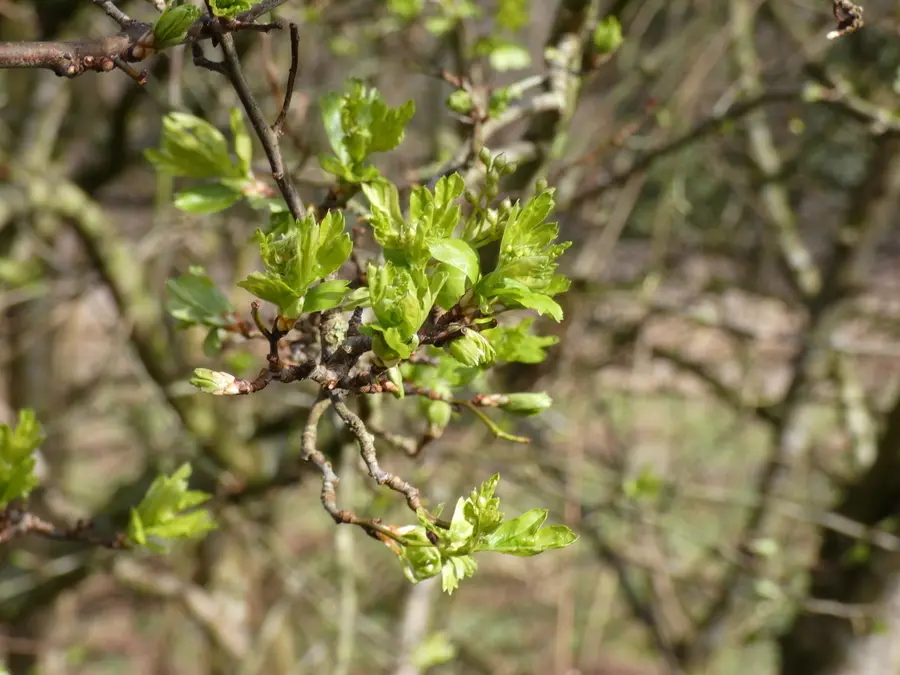 Bodenham Lake – A Chaffinch calls from trees in the car park. A Kestrel is at the very top of one of the Lombardy Poplars. The sound of a drumming Great Spotted Woodpecker comes from the lakeside wood. On the boating lake there are five red-head Goosander gliding around and a male flies in. There is also a small flock of Tufted Ducks and a drake Goldeneye. At the western end of the bay are a few Wigeon and the water level has dropped just enough for a little bit of an island to appear and provide a perch for a Cormorant.
Bodenham Lake – A Chaffinch calls from trees in the car park. A Kestrel is at the very top of one of the Lombardy Poplars. The sound of a drumming Great Spotted Woodpecker comes from the lakeside wood. On the boating lake there are five red-head Goosander gliding around and a male flies in. There is also a small flock of Tufted Ducks and a drake Goldeneye. At the western end of the bay are a few Wigeon and the water level has dropped just enough for a little bit of an island to appear and provide a perch for a Cormorant.
Onto the meadow. A Song Thrush sings in the trees. A lot of fresh molehills have been thrown up. Into the hide. Opening the window scares off a Grey Heron and a Great White Egret. Several more Goosander are at the western end. A dozen Teal are beside the island. Mallard are scattered around the water. Around twenty Mandarin Duck chase around in circles in the island woods on a flooded area. A good number of Canada Geese create a cacophony. More Teal are at the western end. A red-head Goosander is diving over the submerged scrape. A flotilla of Mandarin Ducks emerge from the woods. A number of Wigeon glide out from behind the island.
Back along the top of the meadow. Yellow Hazel catkins hang thickly and the first leaves are on the Hawthorns. Fieldfares are still feasting on the cider apples. Mistle Thrushes fly around the trees. A Song Thrush sings. A Green Woodpecker yaffles near the car park. Many of the fields in the area have large areas of flood water on them.
Friday – Staunton-on-Wye – A cold day with a bitter wind. The village of Staunton-on-Wye is stretched out parallel to the Hereford-Brecon road, a Roman Road. Much of the western end of the village is modern  and new development has taken place along the road towards the east. 17th and 18th century timber-framed and often thatched houses are scattered along the road. The
and new development has taken place along the road towards the east. 17th and 18th century timber-framed and often thatched houses are scattered along the road. The  church stands at the far eastern extent of the village by Oakchurch farm, on a hill overlooking the Wye valley and a large garden centre.
church stands at the far eastern extent of the village by Oakchurch farm, on a hill overlooking the Wye valley and a large garden centre.
The church of St Mary is 12th century with later additions including a 13th century tower. The chancel was rebuilt in 1720. A Norman window and a blocked Norman door face the main entrance. The organ sits in the base of the tower – an odd looking arrangement. The chancel furniture is 17th century. Fine Victorian tiling is on the eastern wall. The tub font is Norman with a rather pleasing wooden lid. A modern sundial is on the apex of the porch. In the churchyard is a recumbent effigy in sandstone of a woman with long gown holding a heart with an ogeed foiled canopy over the head. Her head is severed from body. It is believed to be of an early 14th century date.
Monnington-on-Wye – Across the Roman Road and down a lane to small settlement of Monnington-on-Wye. Past large Bulmers’ cider orchards. Sizeable flocks of winter thrushes move around these orchards. The settlement was owned by Harold Godwinson, passing to Ralph de Tosny after the Conquest and is referred to in the Domesday Book as Manitune, meaning “Manna’s settlement”, Monnington Court is the main house of the place. Another farm and the former rectory lay some way to the north west and there is a large lodge house by the road. Monnington Court is 14th century although it is suggested the building is based on a Moot Hall dating before 1230. It was extended in the 17th century and re-fronted in the early 18th century. It was the seat of the Monnington family. Hugh de Monington was High Sheriff of Herefordshire in 1390. Roger Monnington married Owain Glyndŵr’s daughter Margaret. Uvedale Tomkins purchased Monnington Court in the 1670s. A supporter of the Restoration, with the help of Colonel Birch, he got himself elected to  Parliament as one of the two MPs for Weobley alongside Birch. Sir Thomas Tomkins created Monnington Walk, a mile long avenue of Scots Pines and Yews to celebrate his election as MP in 1623. The court passed to the Cornewall family who lived across the River Wye at Moccas Court. They owned it until until 1965. The bad winter of 1960 had wrecked the toll bridge and made the land inaccessible from Moccas, so the farm was sold to Bulmers Ltd.
Parliament as one of the two MPs for Weobley alongside Birch. Sir Thomas Tomkins created Monnington Walk, a mile long avenue of Scots Pines and Yews to celebrate his election as MP in 1623. The court passed to the Cornewall family who lived across the River Wye at Moccas Court. They owned it until until 1965. The bad winter of 1960 had wrecked the toll bridge and made the land inaccessible from Moccas, so the farm was sold to Bulmers Ltd.
A track leads to the church from the lane alongside a stream which runs around the church. A 17th century lych gate stands somewhat isolated between the stream and an old wall. Into the churchyard where a number of Wellingtonias stand. A large old Yew stands in front of the entrance porch. 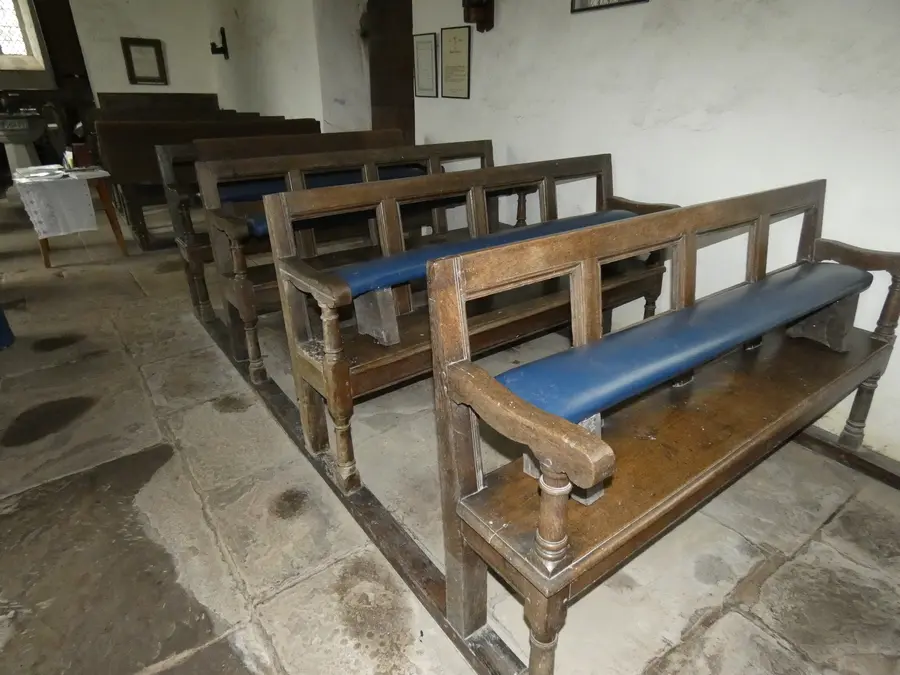 Uvedale Tomkins rebuilt the original 13th century church in 1679. His coat of arms is on the exterior eastern wall. The interior is whitewashed. Uvedale was at pains to erect an elaborate copy of the arms of Charles II on the wall, possibly to stifle comment that the furnishings of the church were strongly Puritan. A large black ledger stone to him is on the chancel wall, (name spelled Tomkyns). 17th and 18th century tombstones lie in front of altar. A fine white monument is to Robert Perrot, born in 1592 in Morton on Lugg and died in 1657, at age 65. The pews are simple wooden benches. The font has an octagonal bowl with moulded under edge, tapering stem and moulded base; on face of bowl initials and date, V. and M.T., 1680. the church has no gas, electricity or water supplies and bottled gas heaters lay around the building. There are four bells; 1st by Godwin Baker of Worcester, 1615; 2nd by Clibury, 1610; 3rd mediæval and inscribed in Lombardic capitals, “Eternis anis resonet campana Joannis”. It has long been believed by some that Owain Glyndŵr is buried in the churchyard but there has never been any evidence found for this belief. Kilvert’s sister Thermuthis (known as Thersie) was married to the Revd William Smith of Monnington and the diarist often visited them. Beyond the churchyard, cast heads on stands are in a circle in the garden of the court.
Uvedale Tomkins rebuilt the original 13th century church in 1679. His coat of arms is on the exterior eastern wall. The interior is whitewashed. Uvedale was at pains to erect an elaborate copy of the arms of Charles II on the wall, possibly to stifle comment that the furnishings of the church were strongly Puritan. A large black ledger stone to him is on the chancel wall, (name spelled Tomkyns). 17th and 18th century tombstones lie in front of altar. A fine white monument is to Robert Perrot, born in 1592 in Morton on Lugg and died in 1657, at age 65. The pews are simple wooden benches. The font has an octagonal bowl with moulded under edge, tapering stem and moulded base; on face of bowl initials and date, V. and M.T., 1680. the church has no gas, electricity or water supplies and bottled gas heaters lay around the building. There are four bells; 1st by Godwin Baker of Worcester, 1615; 2nd by Clibury, 1610; 3rd mediæval and inscribed in Lombardic capitals, “Eternis anis resonet campana Joannis”. It has long been believed by some that Owain Glyndŵr is buried in the churchyard but there has never been any evidence found for this belief. Kilvert’s sister Thermuthis (known as Thersie) was married to the Revd William Smith of Monnington and the diarist often visited them. Beyond the churchyard, cast heads on stands are in a circle in the garden of the court.
Back to the lane and to the start of Monnington Walk. The sky fills with Fieldfares and Redwings as a vast flock flies out of one orchard to another.
Saturday – Leominster – On my way to the Farmers’ Market I hear a shriek from above as a parrot shaped bird speeds over. There has been talk of an escaped parrot but I suspect this a Ring-necked Parakeet. This may indicate they have arrived in the area having spread out from the south east of the country and we will now have the very dubious pleasure of their noise.
Off to the Priory church for the annual seed swap. I take a few runner and climbing beans, but I do not have many – we ate the majority! There are also few seeds that I need, but I pick up a beetroot variety I have not heard of before – Crosbys Egyptian, apparently an American heirloom variety that is very flat in shape. However, it is a good opportunity to catch up with some Town Councillors to swap news.
Home – A couple of trays of lettuces are sown – Little Gem and Romana, a tray of Summer Purple Sprouting Broccoli and a pot of Crimson Flowered Broad Beans. A row of radishes are also sown but these are very old seeds and I am not optimistic about their viability.
Sunday – Leominster – Out into the rain on a dull morning under a uniform grey sky. Jackdaws alight on chimney stacks to inspect them for potential nesting sites. Up onto the railway bridge. A good number of Wood Pigeons fly off across the fields. Onto Butts Bridge. A Dipper squeaks from the rocks upstream from the bridge before flying off rapidly. A second bird remains on the rocks. The water level in the river is little changed. Eaton hill is lost in the mist. A Mistle Thrush rasps in the trees. Many of these trees have buds beginning to swell.
Back over the railway and round to Pinsley Mill. A lone Carrion Crow sits at the top of one of the trees and another pair fly over high in the sky. A Dunnock sings from the bushes. Now both a Song Thrush and a Robin join in. More Robins sing on either side of the Millennium Park. Blue Tits churr. Two pairs of Bullfinches are pecking at leaf buds on a Hawthorn. Like the Lugg, the River Kenwater is also unchanged from last week.
Into the churchyard where Blackbirds are searching the leaf litter. The swelling notes of the organ boom out from the Priory church. Into Church Street. A large Georgian house next to The Old Vicarage has been up for sale for some time now and as beginning to look tatty. The bells of the Minster ring out the hour followed by the summons to morning prayer. House Sparrows chatter outside the Forbury.
Home – The chicken run is dug out. Two wheelbarrow loads of rotted grass and droppings are dumped on the bed that will be soon trenched for potatoes and a bale of fresh straw and chippings are spread across the run. The hens mutter contentedly as they scratch and peck at their new carpet.
Wednesday – Leominster – Yet another grey, cold morning. Down to the 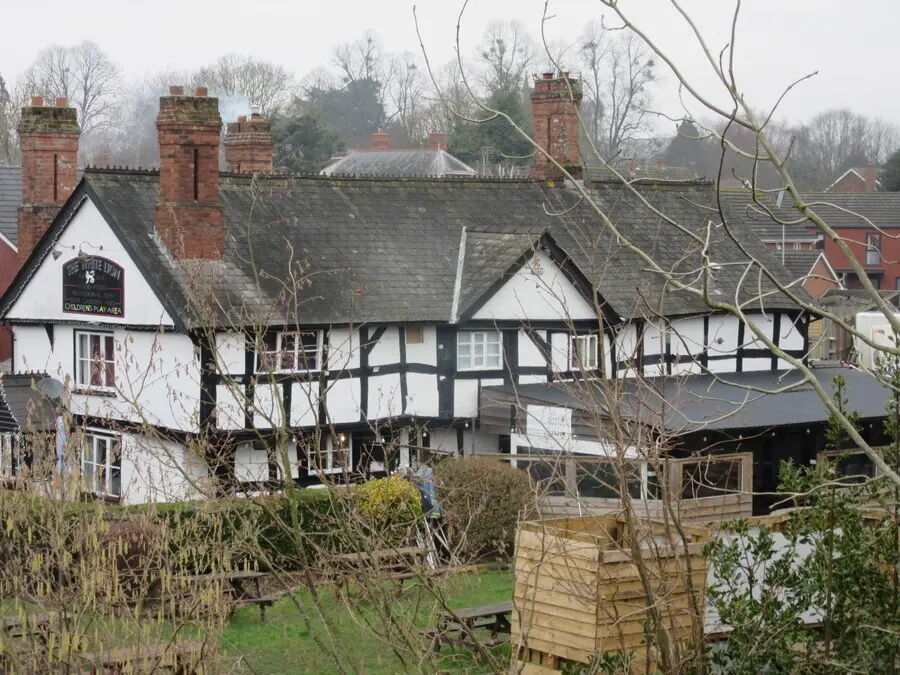 railway bridge. Strangely there are few Jackdaws here, they must all be back at home where there were over thirty in the trees in our garden this morning. House Sparrows chatter in the bushes behind the station car park. Robins and Wrens sing in the riverside trees. A Goldfinch alights upon a Teasel by the bridge. The River Lugg flows steadily, the water grey reflecting the sky. A Song Thrush sings somewhere upstream. A pair of Carrion Crows flyover, one carrying something in its beak.
railway bridge. Strangely there are few Jackdaws here, they must all be back at home where there were over thirty in the trees in our garden this morning. House Sparrows chatter in the bushes behind the station car park. Robins and Wrens sing in the riverside trees. A Goldfinch alights upon a Teasel by the bridge. The River Lugg flows steadily, the water grey reflecting the sky. A Song Thrush sings somewhere upstream. A pair of Carrion Crows flyover, one carrying something in its beak.
Back round past the White Lion. This is a strange building. To the road is a brick wing. To the rear (which the listing calls the front) is a fine 16th century former house frontage with jettying. Rather spoilt by a modern wooded “smoking” area. A small flock of Blue and Long-tailed Tits flies from Pinsley Road over the railway into the bushes. A pair of Jackdaws fly over and one of these has something in its beak. Into the Millennium Park, Blackbirds Chaffinches, a Magpie and Blue Tits are all feeding on and beneath the trees. More and more Snowdrops have come into bloom. It is a glorious sight.
Thursday – Home – At dawn, over 100 Jackdaws are in the trees behind the house. Over 30 are in our Ash and over 70 in the Horse Chestnut that stands over the wall. The flock is mobile with much coming and going. By 8:30am they have departed. Later in the morning any gaps under the chicken run are sealed with soil and pebbles to ensure wild birds cannot get in. There is a nationwide Avian Flu alert in force. A hole by the wall that may have been made by a rat is filled with gravel. The wire cloches are repaired. The first potato trench is dug.
Friday – The Weir – We visit the Weir, a National Trust site. We have not been here for a number of years. The garden is on a steep slope down to the River Wye a single male Goosander is preening on the water. Display of Snowdrops is wonderful covering the hillside but the Winter Aconites seem to have disappeared. Borage is coming into flower. We do not stay long as there is a bitter wind cutting into our faces.
Sunday – Leominster – The sky is converted in thin, high cloud. It is cool with a chilly light wind. A Blue Tit churrs in one of the pollarded trees. The usual chacking of Jackdaws comes from the chimney stacks. Over the railway and onto Butts Bridge. The water level in the River Lugg has risen slightly. From above come the calls of Magpie and Mistle Thrush. Two Mistle Thrushes fly over and perch next to a large ball of Mistletoe. One flies off back over the river to land in one of the great Black Poplars was the other also in another Black Poplar on the west side of the river gets very agitated calling and flicking its wings. A Turkish Airlines Istanbul to New York Airbus flies over leaving twin vapour trails.
Back over the railway. A huge amount of debris from the town centre works remains in the compound by the ginnel. Into Pinsley Mill. Several Blue Tits, a Chaffinch, Wood Pigeon and Blackbird are in the bushes across the railway a Song Thrush and a Great Tit are in full voice further back in the scrubland. More Blue Tits, Chaffinches, Blackbirds and a singing Robin are in the orchard. Two Magpies seem wary of each other in the trees at the foot of the churchyard. Ransoms, Wild Garlic, are appearing under the trees.
The sky is still busy with a cargo-carrying 747 from Luxembourg to Mexico City and a 737 from Leeds to Tenerife passing over. The River Kenwater is flowing fairly swiftly. There is plenty of birdsong; Robins, Song Thrush, Chaffinch, Blackbird, Blue Tits and Great Tit. Bell ringing practice starts. As usual it is rather cacophonous when it begins.
Into Church Street. A Wood Pigeon calls from the top of the Forbury chapel. It may be rather in vain as the bells suddenly drown it out, so it flies off possibly to a new perch where it may be heard. Tarpaulin covers the windows of the Hen Pen, the former wine shop on Buttercross, that has been unused for at least 20 years now. Maybe something is actually happening to it.
Monday – Leominster – At dawn there was brightness in the eastern sky. Now, although it is still vaguely brighter in the east, overall everything is just grey. It is cold. Past the leisure centre and the secondary school whatever is called these days the car park is empty, it is half term. Into South Street. A Border Collie watches from an upstairs window. South Street becomes Hereford Road. Two Dunnocks sing loudly in competition from a garden. Jackdaws are on chimney pots, aerials and roofs. A large flock of Wood Pigeons flies over.
Up between large green fields to Cockcroft Lane. It is not clear whether the fields have been set to grass or a cereal. From the ridge top, the view is misty, distant hills hidden and even the closer ones can be barely discerned. There is only a little water now on the Arrow flood plain. Steam rises from a large building in the sea of poly tunnels. The hills behind rise up to Brierley Wood and Ivington Iron Age fort. It seems slightly odd there is no hill fort on this ridge of land or on the next eastwards, Eaton Hill. Evidence of iron working, probably pre-Roman, has been found close to the Priory and there are historical references to a lost round barrow near the foot of Bargates. Another Bronze Age barrow is believed to be below here on the other side of Passa Lane.
Along the hilltop to Ryelands and back into town. The day is slowly brightening.
Tuesday – Home – It is a bright sunny morning with high cloud dotted 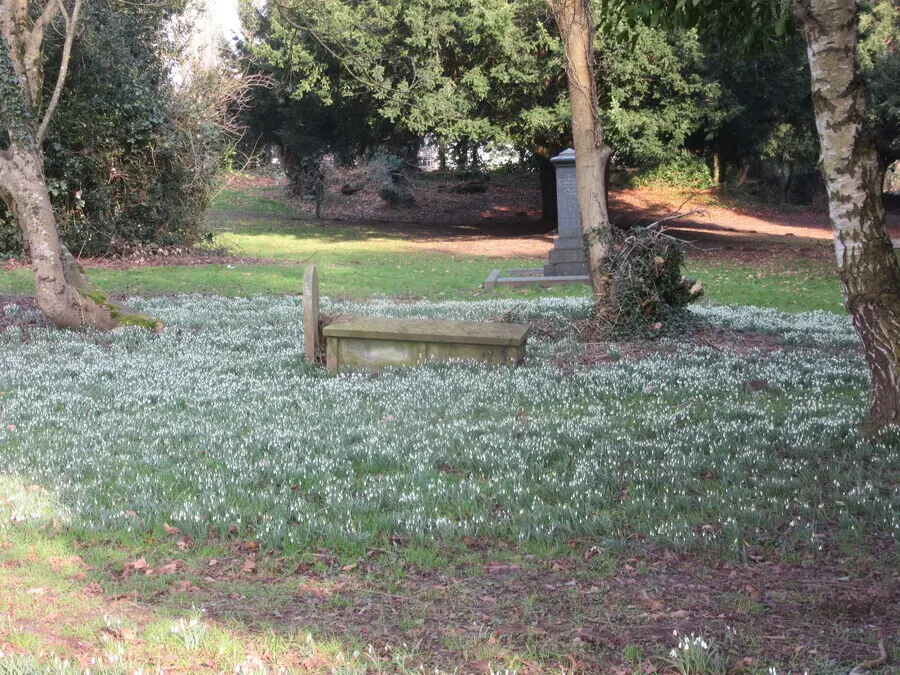 around the sky. It is cold though, water in the bird bath has a veneer of ice on it. Bird calls and song ring out – Blackbird, Dunnock, Robin, Great and Blue Tits and a Magpie. A sudden flurry of House Sparrows chirping loudly is in a large Laurel bush.
around the sky. It is cold though, water in the bird bath has a veneer of ice on it. Bird calls and song ring out – Blackbird, Dunnock, Robin, Great and Blue Tits and a Magpie. A sudden flurry of House Sparrows chirping loudly is in a large Laurel bush.
Leominster – Through the Millennium Park and into the churchyard. The spread of Snowdrops is quite remarkable over the past few years. There is now a considerable area of them. A Wren is ticking furiously. Down the Priory and over the Kenwater. Blue Tits are chattering away in the bushes on both sides of the river. Guttering and fixings are purchased for the chicken run. Back home I prove incapable of cutting a disc in wood to block the downpipes from the guttering so a small pipe can been put in it to send water into the butts. In the end I glue plastic discs with a small hole for a tube over the downpipes and when they are well set I will erect the gutters.
Saturday – Home – I finally attach the down pipe to the hen run guttering and insert the hose. All seems solid enough. Despite lowering the downpipe end, the water still is slow to pour out. Of course, it was unlikely the fence would be level! So the gutter will probably have to be tilted even further. Two troughs are emptied in the greenhouse. Two other still have large pak choi plants in them and these will have to be used soon as they are about to bolt. Another oriental green leaves are in the main bed and growing very slowly. Maybe the warmer weather will encourage them. A Blackcap is singing in the Ash tree, surely an over-wintering bird.
Sunday – Leominster – Grey clouds race north westwards through a luminous yellow-orange sky. An hour later the sky is just grey. A chill westerly wind is blowing. The wind seems to have quietened the Jackdaws. A Dunnock sings by the White Lion. An ambulance wails on the bypass. The water level in the River Lugg has not changed since last week nor has the water’s colour. Back over the railway bridge. Two Dunnocks are in the bushes beside the railway. Dunnocks are monomorphic, i.e. the male and female are identical, however one is flicking its wings and singing in front of the other so one assumes that is the male trying to impress a female. She flies off and he chases after her.
Into Pinsley Mill. Two Magpies fly over – two for joy. Gulls drift on the wind overhead, their wings motionless as they use the air currents. Wild Garlic, Wild Arum and daffodils are still rising from the muddy ground along the edge of the churchyard in the Millennium Park. The River Kenwater still flows rather swiftly. A “Kingfisher” turns out to be a scrap of turquoise plastic on a twig.
Chaffinches, Robins and Dunnocks are singing in the churchyard. The Minster bells ring out the hour followed by the call to prayer. Even more dog walkers here as Pinsley Mead is completely blocked now as repairs are carried out on the old Priory building and youth hostel.
Home – A Castor Oil type plant that has almost died is removed from next to the Summerhouse. A Mimosa is tidied up.
Tuesday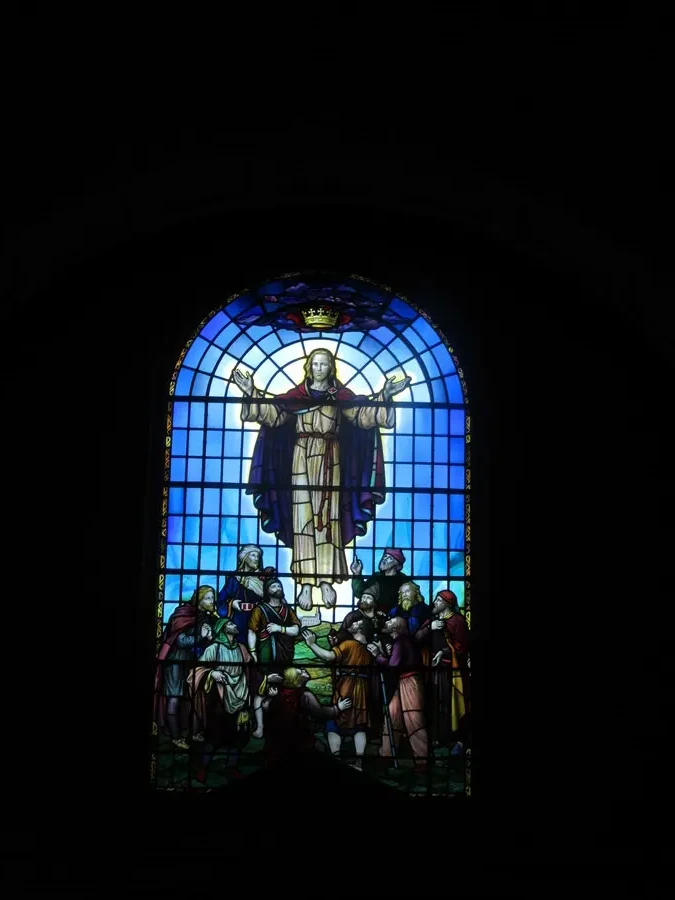 – Bath – We travel by train to Bath. It is an easy journey. From Bath Spa station we wander through the shopping centre. Huge buildings in Bath Stone look traditional but are modern. We pause for a coffee and hot chocolate then walk past the Theatre Royal towards The Circus. Queens Square is a park with an obelisk erected by Beau Nash in 1738 in honour of Frederick, Prince of Wales. The surrounding houses were started by John Wood, the Elder in the early 18th century. He designed the building frontages following the rules of Palladian architecture and then sub-let to individual builders to put up the rest of the buildings.
– Bath – We travel by train to Bath. It is an easy journey. From Bath Spa station we wander through the shopping centre. Huge buildings in Bath Stone look traditional but are modern. We pause for a coffee and hot chocolate then walk past the Theatre Royal towards The Circus. Queens Square is a park with an obelisk erected by Beau Nash in 1738 in honour of Frederick, Prince of Wales. The surrounding houses were started by John Wood, the Elder in the early 18th century. He designed the building frontages following the rules of Palladian architecture and then sub-let to individual builders to put up the rest of the buildings.
Through The Circus, a ring of large townhouses also designed by architect John Wood, the Elder and built between 1754 and 1768. On to the Assembly Rooms designed by John Wood the Younger in 1769, but they are closed. Christ Church was designed by John Palmer in 1798 and was one of the first churches to offer 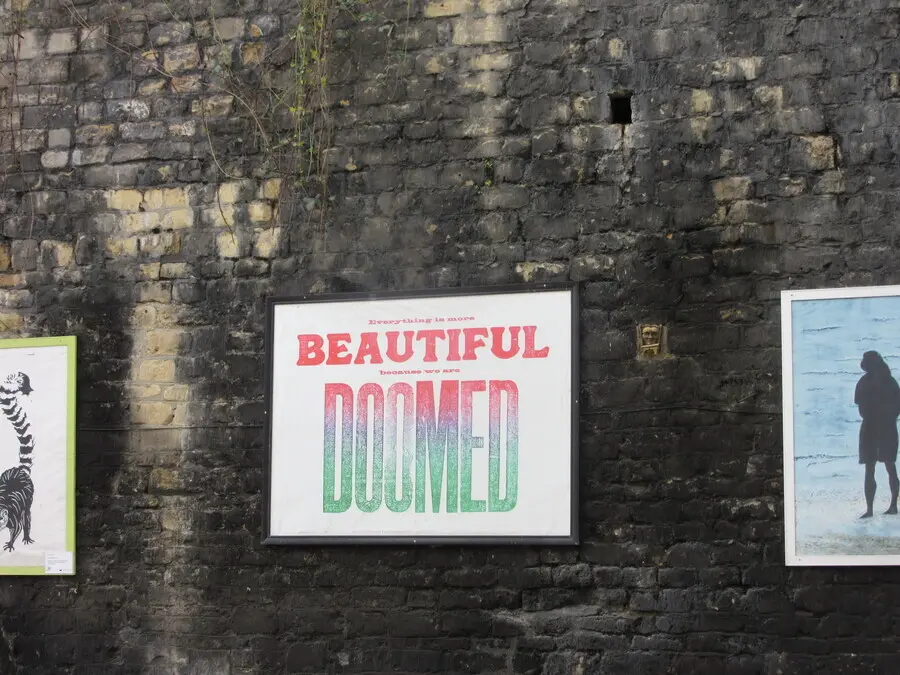 free pews. It is also closed. On to The Paragon in the area of Walcott and St Swithin’s church.
free pews. It is also closed. On to The Paragon in the area of Walcott and St Swithin’s church.
The church of St Swithin was built between by John Palmer between 1777 and 1790. It stands on the site of a previous church dating back to the 10th century, the remains of which are beneath the crypt. It is a very fine Georgian church, the last still standing in Bath. Jane Austen’s parents were married in 1764 in the earlier church and her father George Austen is buried there. William Wilberforce and Barbara Spooner Wilberforce were married here in 1797. The church is simple, all the walls covered in memorials. A single stained glass window stands above the altar table. A balcony runs all the way around the interior. Other windows have delicately coloured glass in a diamond pattern.
Down Walcott Road where some excellent artwork is displayed a large retaining wall. At the foot of the wall is Ladymead Fountain, a free public fountain designed by Major Charles Davis, originally called Camwell Fountain and located by the cattle market. Street junctions are noted on a paving stone, often too worn to read. Through the rather splendid market where an old pillar or “nail” has stood since 1768. It was used for business transactions and 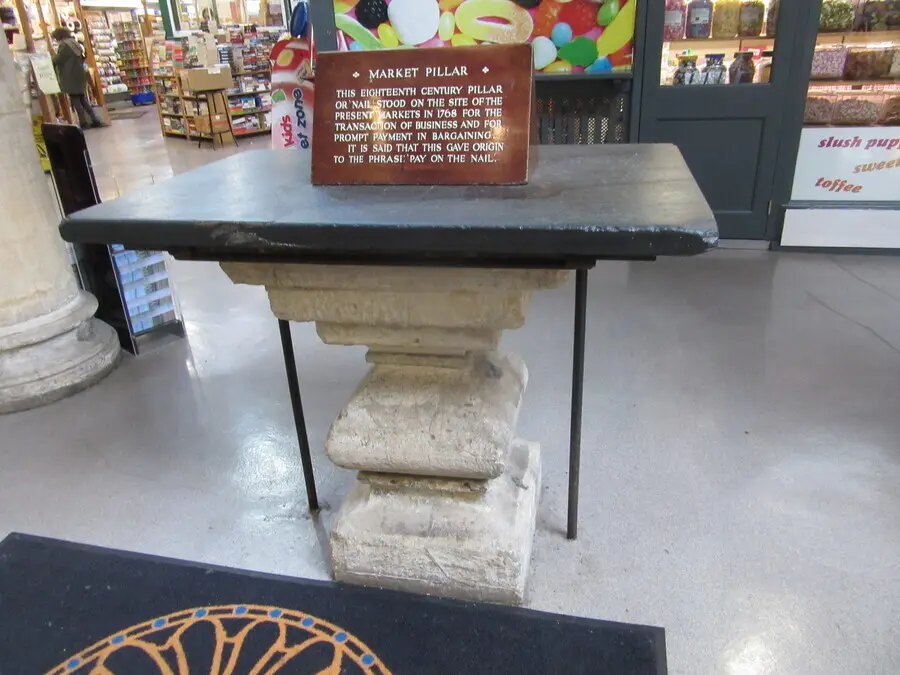 payment, hence the phrase, “to pay on the nail”.
payment, hence the phrase, “to pay on the nail”.
 On to the Abbey. Last time we visited the Abbey Church of St Peter and St Paul it was horrendously crowded and we did not stay long. Now there are still people but there is a much more peaceful air. The site was first settled as a convent in 675CE when King Osric of the Hwicce gave land near Bath to the Abbess Bertana, to found a “Convent of Holy Virgins”. It became a monastery under the patronage of the Bishop of Worcester. King Offa of Mercia took it from the bishop in 781. William of Malmesbury tells that Offa rebuilt the monastic church. In 944 it was in the hands of King Edmund I who gave it to a group of monks who opposed the conversion of the Abbey of Saint Bertin in France along Benedictine lines. However, it became a Benedictine monastery shortly after and remained so until Dissolution. After the Conquest, William II Rufus, granted the city to a royal physician, John of Tours, who became Bishop of Wells and Abbot of Bath. In 1090 the bishopric was moved from Wells to Bath. A new abbey was under construction when it was burned down in 1137. The rebuilding continued into the latter half of the 12th century. Prior Holloway surrendered Bath Priory to the crown in January 1539. It was sold to Humphry Colles of Taunton. The abbey was stripped of its co-cathedral status when the cathedral was consolidated in Wells. The church was stripped of iron, glass and £4,800 worth of lead and left to decay. In 1574, Queen Elizabeth I promoted the restoration of the church, to serve as the grand parish church of Bath. The restoration work on the Abbey financed by Montague was completed by 1611. Major restoration work was carried out by Sir George Gilbert Scott in the 1860s, funded by the rector, Charles Kemble. The work included the installation of fan vaulting in the nave. The building has 52 windows, occupying about 80% of the wall space, filling the interior with light. There are many famous names on the 617 wall memorials and 847 floor stones.
On to the Abbey. Last time we visited the Abbey Church of St Peter and St Paul it was horrendously crowded and we did not stay long. Now there are still people but there is a much more peaceful air. The site was first settled as a convent in 675CE when King Osric of the Hwicce gave land near Bath to the Abbess Bertana, to found a “Convent of Holy Virgins”. It became a monastery under the patronage of the Bishop of Worcester. King Offa of Mercia took it from the bishop in 781. William of Malmesbury tells that Offa rebuilt the monastic church. In 944 it was in the hands of King Edmund I who gave it to a group of monks who opposed the conversion of the Abbey of Saint Bertin in France along Benedictine lines. However, it became a Benedictine monastery shortly after and remained so until Dissolution. After the Conquest, William II Rufus, granted the city to a royal physician, John of Tours, who became Bishop of Wells and Abbot of Bath. In 1090 the bishopric was moved from Wells to Bath. A new abbey was under construction when it was burned down in 1137. The rebuilding continued into the latter half of the 12th century. Prior Holloway surrendered Bath Priory to the crown in January 1539. It was sold to Humphry Colles of Taunton. The abbey was stripped of its co-cathedral status when the cathedral was consolidated in Wells. The church was stripped of iron, glass and £4,800 worth of lead and left to decay. In 1574, Queen Elizabeth I promoted the restoration of the church, to serve as the grand parish church of Bath. The restoration work on the Abbey financed by Montague was completed by 1611. Major restoration work was carried out by Sir George Gilbert Scott in the 1860s, funded by the rector, Charles Kemble. The work included the installation of fan vaulting in the nave. The building has 52 windows, occupying about 80% of the wall space, filling the interior with light. There are many famous names on the 617 wall memorials and 847 floor stones.
Wednesday – Bath – We cross the River Avon by Pulteney Bridge. Completed in 1774, it connected the city with the land of the Pulteney family which the family wished to develop. Designed by Robert Adam in a Palladian style, it is highly unusual in that it has shops built across its full span on both sides. Great Pulteney Street is a wide thoroughfare past magnificent terraces of Georgian houses Commissioned by Sir William Pulteney. It was designed by the architect Thomas Baldwin and completed in 1789. A fountain stands on a small roundabout in Laura Place. At the head of the road is Holburne House, a museum and art gallery built around the collection of Sir William Holburne, the 5th Baronet (1793-1874). His collection of over 4,000 objects, pictures and books was bequeathed to the people of Bath by his 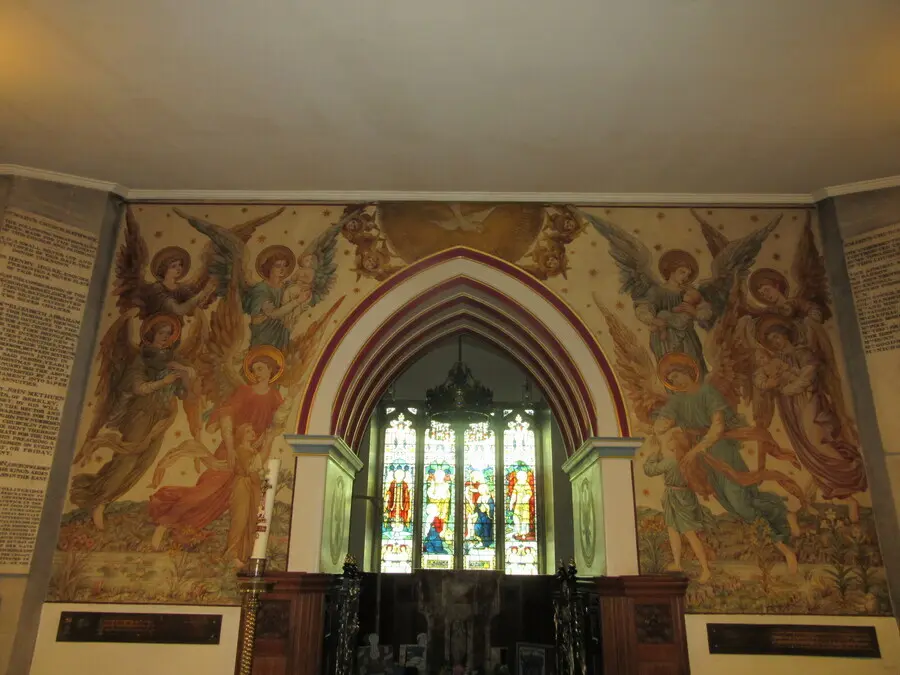 sister, Mary, in 1882. We had come to see an exhibition of iconic modern art including pieces by Warhol, Peter Blake, Pauline Boty and Francis Bacon. However, it is an exhibition of work by Joshua Donkor (b. 1997) a Ghanian-British painter who grew up in Bath, that really captivates us.
sister, Mary, in 1882. We had come to see an exhibition of iconic modern art including pieces by Warhol, Peter Blake, Pauline Boty and Francis Bacon. However, it is an exhibition of work by Joshua Donkor (b. 1997) a Ghanian-British painter who grew up in Bath, that really captivates us.
A short distance along the road is the church of St Mary the Virgin Bathwick, an Anglican church with a strong Catholic flavour built by 1814–20 by John Pinch the Elder, with the chancel by GE Street, 1873–5. It was built for the Pulteney family. Pevsner states “Meant to be in the Somerset Gothic style, though of course the result is typical of early 19th century”. Stations of the Cross are around the walls. The High Altar is by Sidney Gambier Parry. The reredos contains four panels from a 15th century Flemish triptych. The original altar painting, an Adoration of the Child by Benjamin Barker, hangs high up against the west wall, where it was placed after a ruinous fire in 1916. This fire also destroyed many wall paintings, the only one left is a lovely Arts and Crafts mural by Alfred O. Hemming. The glass throughout is by Clayton and Bell. The font is Early English from the original church which stood nearby.
We return over Pulteney Bridge and stand by the River Avon watching workers trying to extract a large tree trunk and branches from the water with a JCB. They get so far and then seem to give up. Must be lunchtime. I am aching rather so we retire to one of a number of fine hostelries in the narrow streets of the city centre.